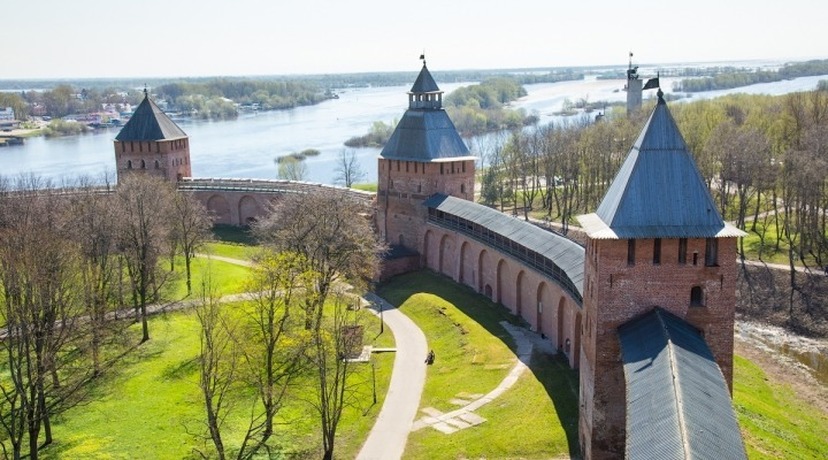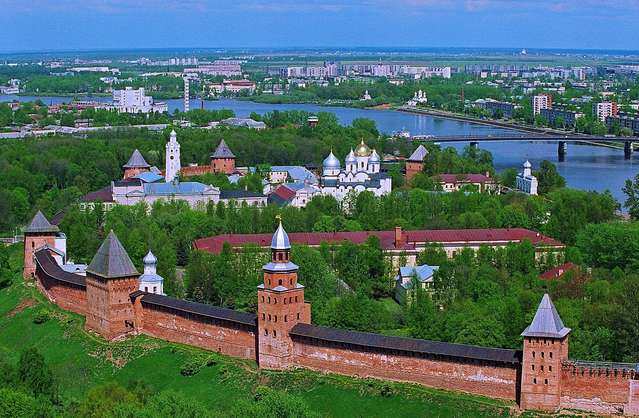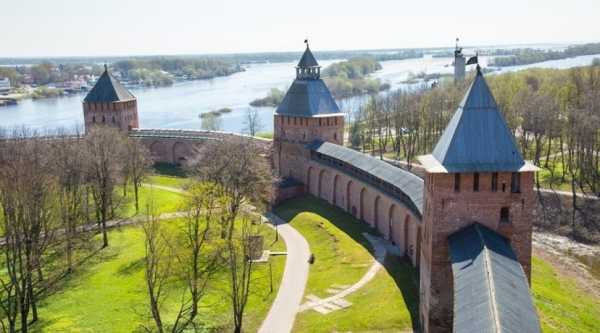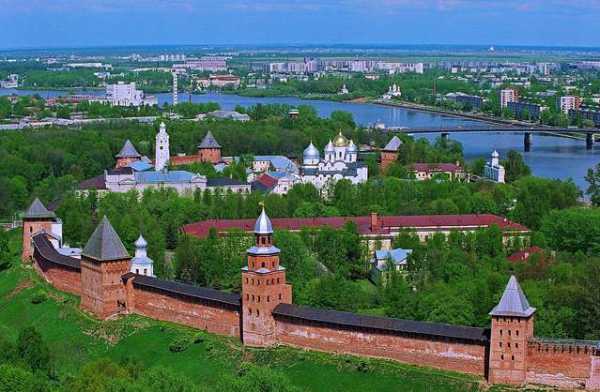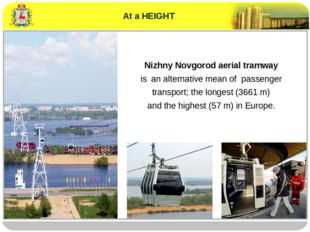Нижний Новгород – город множества достопримечательностей.
Nizhny Novgorod Kremlin – Нижегородский Кремль
- The center and the heart of the city – центр и сердце города
- The city authorities – городская власть
- The region governor administration – администрация губернатора области
- The legislation authorities – законодательная власть
The Kremlin is the center and the heart of the city. It’s the place where the history of Nizhny Novgorod started.
Nizhny Novgorod Kremlin includes 5 square towers with the gates and 8 round ones.
The city authorities, the region governor administration and the legislation authorities are situated inside the Kremlin walls. Moreover, there are religion and cultural sights such as Mikhaylo-Arkhangelsky Cathedral, Eternal Flame and museums.
Nizhny Novgorod Fair– Нижегородская ярмарка
- Famous exhibition center – известный выставочный центр
- Market place – ярмарочное место
- Superb modern exhibition complex – превосходный современный выставочный комплекс
Founded ages ago now Nizhny Novgorod Fair is both a great historical and architectural tourist attraction and a famous exhibition center.
Nizhny Novgorod Fair has a great history. Actually it was a market place but after renovating the fair has become a superb modern exhibition complex that now welcomes different international events, fairs, and conventions.
Nizhny Novgorod State Art Museum Rukavishnikov Mansion– Нижегородский государственный художественный музей
- The City Art and Historical Museum – городской художественный и исторический музей
- Gain a great history – обрести великую историю
- Diverse and rich collection of paintings – разнообразная и богатая коллекция картин
- Masterpieces – шедевры
The Nizhny Novgorod State Art Museum is one of the oldest museums in Russia. Being founded in 1896 as “The City Art and Historical Museum” it has gained a great history and now has got a diverse and rich collection of paintings of different trend and genre. There are masterpieces both of Russian and European painters.
Rukavishnikov Mansion – Усадьба Рукавишниковых
- This exhibition space – выставочное пространство
- Mansion – усадьба
- Illustrious interior – знаменитый ресторан
This exhibition space is located inside a 19th-century mansion once belonging to the Rukavishnikov merchant family. There you can wander through the rooms on your own or join one of the hourly 40-minute excursions in Russian and English. Furniture and the interior are illustrious.
Chkalov Staircase – Чкаловская лестница
- A monumental erection of the Soviet era – монументальное сооружение советской эпохи
- Derive its name – получить свое название
- At the top of the stairs – в верхней части лестницы
- An immense sum – огромные деньги
- The river embankment – набережная реки
- Flight of stairs – лестничный пролет
The Chkalov Staircase is a great and monumental erection built in the Soviet era. The construction of the staircase cost an immense sum at the time – almost 8 million rubles and was built by German prisoners of the war. The staircase derives its name from pilot Valery Chkalov. He was the first man who flew from Moscow to Vancouver through the North Pole in 1937. There is a monument to Chkalov at the top of the stairs. Staircase numbers at about 1,500 stairs that connect the river embankment with the city center.
Сочинение на тему «Нижний Новгород»на английском языке с переводом на русский язык |
|
Nizhny Novgorod |
Нижний Новгород |
|
Nizhny Novgorod is one of the largest cities in Russia (the population is over a million people), an important economic and cultural center of the Volga region. The city is ancient and incredibly beautiful: along with Vladimir, Suzdal, Yaroslavl, it contains a great historical heritage of the medieval Rus. Nizhny Novgorod is situated on two rivers, the Oka and the Volga, so it is a significant point of commercial and touristic shipping. |
Нижний Новгород – один из самых больших городов России (население превышает миллион человек), важный экономический и культурный центр Поволжья. Город древний и невероятно красивый: наряду с Владимиром, Суздалем, Ярославлем, он содержит великое историческое наследие средневековой Руси. Нижний Новгород расположен на двух реках, Оке и Волге, поэтому является значимым пунктом коммерческого и туристического судоходства. |
|
The city was born long ago: the Slavic tribes settled on its territory since the 9th century, and in the 13th century, the prince of Vladimir founded there a fortress. The prosperity of Vladimir and Suzdal Princedoms caused the population growth. Later, the city was joined to Moscow lands. In the beginning of the 17th century, Minin and Pozharsky organized the Nizhny Novgorod volunteer corps that freed Moscow from the foreign intervention. As a part of Russian Empire, Nizhny Novgorod was the guberniya’s center and a hotbed of the merchant trade. |
Город родился давно: славянские племена селились на его территории с IX века, а в XIII веке князь Владимира основал там крепость. Процветание Владимирского и Суздальского княжеств вызвало рост населения. Позднее город был присоединён к землям Москвы. В начале XVII века Минин и Пожарский организовали Нижегородское ополчение, которое освободило Москву от иностранной интервенции. В составе Российской империи Нижний Новгород был центром губернии и очагом купеческой торговли. |
|
Afterward, in the USSR epoch, Nizhny Novgorod became an industrial megacity under the name Gorky. Therefore, nowadays it has improved infrastructure and industry, including automobile and shipbuilding plants. There are several prestigious universities and big libraries. |
Впоследствии, в эпоху СССР, Нижний Новгород стал индустриальным мегаполисом под именем Горький. Поэтому в наши дни он обладает развитыми инфраструктурой и промышленностью, включая автомобильный и судостроительный заводы. Есть несколько престижных университетов и крупных библиотек. |
|
Numerous churches (for example, the amazing Alexander Nevsky Cathedral) and merchants’ houses, as well as the huge 16th century Nizhny Novgorod Kremlin attract many tourists to the city. The gorgeous baroque building of Nizhny Novgorod Fair hosts various exhibitions and lively trade. Besides, there are such interesting places as Russian Photography Museum and the park “Switzerland” with some rare plants. |
Многочисленные церкви (например, восхитительный Собор Александра Невского) и купеческие дома, а также огромный Нижегородский кремль XVI века привлекают в город многих туристов. В пышном барочном здании Нижегородской ярмарки проходят различные выставки и оживлённая торговля. Кроме того, в городе есть такие интересные места, как Русский музей фотографии и парк «Швейцария» с некоторыми редкими растениями. |
- сочинения
Обновлено: 10.01.2023
Nizhny Novgorod is the fourth largest city in Russia, ranking after Moscow, St. Petersburg, and Novosibirsk. It is the economic and cultural center of the vast Volga-Vyatka economic region, and also the administrative center of Nizhny Novgorod Oblast and Volga Federal District.
From 1932 to 1990, the city was known as Gorky after the writer Maxim Gorky who was born there.
The city is an important economic, transport and cultural center of the Russian Federation.
After the destruction of the Mordvin Inazor Obram administrative centre and fillfort named Obran Osh (Ashli) at the site of future stone Kremlin in 1220, a small Russian wooden hillfort was founded by Grand Duke Yuri II of Russia in 1221. Located at the confluence of two most important rivers of his principality, the Volga and the Oka, and Obran Osh was renamed Nizhny Novgorod. Its name literally means Lower Newtown, to distinguish it from the older Veliky Novgorod. Its independent existence was threatened by the continuous Mordvin attacks against it. The major attempt made by Inazor Purgaz from Arzamas in January 1229 was repulsed, but after the death of Yuri II on March 4, 1238 at the Battle of Sit River the Mongols occupied the fortress and the remnants of small Nizhny Novgorod settlement which surrendered without any resistance in order to preserve what had been developed since Purgaz’s attack eight years earlier. Later a major stronghold for border protection, Nizhny Novgorod fortress took advantage of a natural moat formed by the two rivers.
Along with Moscow and Tver, Nizhny Novgorod was among several newly-founded towns that escaped Mongol devastation on account of their insignificance, but grew into (great) centers in vassalic Russian political life during the period of the Tatar Yoke. With the agreement of the Mongol Khan, Nizhny Novgorod was incorporated into the Vladimir — Suzdal Principality in 1264. After 86 years its importance further increased when the seat of the powerful Suzdal Principality was moved here from Gorodets in 1350. Grand Duke Dmitry Konstantinovich (1323–1383) sought to make his capital a rival worthy of Moscow; he built a stone citadel and several churches and was a patron of historians. The earliest extant manuscript of the Russian Primary Chronicle, the Laurentian Codex, was written for him by the local monk Laurentius in 1377.
Everybody believes that his home town is an important place. Many interesting things can be said about Nizhny Novgorod its attractions and residents.
To begin with, Nizhny Novgorod is rather old. Over seven hundred years have passed since ancient tribes built a fortress on a high bank of the Oka River, where it joins the Volga. So, the city was founded in 1221, by Great Russian Prince Jury, a son of Vsevolod. Now it is one of the most beautiful Russian cities and a city of great national importance. It has a great population and is the third largest city in Russia.
Nizhny Novgorod has a rich history. In 1612 K. Minin and D. Pozharsky organized here people’s volunteer troops and made our Motherland free from Polish invaders. Nizhny Novgorod is the birthplace of Kulibin, a self-taught mechanical engineer, Lobachevsky, a mathematician, Melnikov-Pechorsky and M.Gorky, the writers. In 1932 the town was renamed Gorky, in honour and memory of the Great Russian writer, and in 1991 it got the name of Nizhny Novgorod again.
Nizhny Novgorod remembers Peter the great, Pushkin, Shevchenko, Chehov, Shalyapin, Saharov, who visited our city. In the past Nizhny Novgorod was an important commercial centre and the city of powerful merchant families. All Russian Trade Fair was held in Nizhny Novgorod for many years.
Nizhny Novgorod is well-known as a great industrial and transport centre of our country. There are many big factories in it. It is famous for the automobile plant and its cars. Shipbuilding is also developed in our city, a lot of ships for the Volga and other rivers are built here. In Nizhny Novgorod railroads, waterways and airlines meet. In 1985 a regular Metro traffic was added to this transport network.
My native town is a cultural and scientific centre as well. There are many theatres: the opera House, the Drama Theatre, the Puppet show, the Theatre of Young spectators, the Theatre of Comedy. You can also visit a lot of museums, the Art Gallery, cinemas and libraries.
My native town is beautiful in any season. I love it and I am proud to be its citizen.
Полный текст материала Топик «My Native town Nizhny Novgorod» (материал для урока английского языка) смотрите в скачиваемом файле.
На странице приведен фрагмент.
Нижний Новгород – город множества достопримечательностей.
p, blockquote 1,0,1,0,0 —>
Nizhny Novgorod Kremlin – Нижегородский Кремль
- The center and the heart of the city – центр и сердце города
- The city authorities – городская власть
- The region governor administration – администрация губернатора области
- The legislation authorities – законодательная власть
The Kremlin is the center and the heart of the city. It’s the place where the history of Nizhny Novgorod started.
Nizhny Novgorod Kremlin includes 5 square towers with the gates and 8 round ones.
The city authorities, the region governor administration and the legislation authorities are situated inside the Kremlin walls. Moreover, there are religion and cultural sights such as Mikhaylo-Arkhangelsky Cathedral, Eternal Flame and museums.
p, blockquote 2,0,0,0,0 —>
Nizhny Novgorod Fair– Нижегородская ярмарка
- Famous exhibition center – известный выставочный центр
- Market place – ярмарочное место
- Superb modern exhibition complex – превосходный современный выставочный комплекс
Founded ages ago now Nizhny Novgorod Fair is both a great historical and architectural tourist attraction and a famous exhibition center.
Nizhny Novgorod Fair has a great history. Actually it was a market place but after renovating the fair has become a superb modern exhibition complex that now welcomes different international events, fairs, and conventions.
p, blockquote 3,1,0,0,0 —>
Nizhny Novgorod State Art Museum Rukavishnikov Mansion– Нижегородский государственный художественный музей
- The City Art and Historical Museum – городской художественный и исторический музей
- Gain a great history – обрести великую историю
- Diverse and rich collection of paintings – разнообразная и богатая коллекция картин
- Masterpieces – шедевры
The Nizhny Novgorod State Art Museum is one of the oldest museums in Russia. Being founded in 1896 as “The City Art and Historical Museum” it has gained a great history and now has got a diverse and rich collection of paintings of different trend and genre. There are masterpieces both of Russian and European painters.
p, blockquote 4,0,0,1,0 —>
Rukavishnikov Mansion – Усадьба Рукавишниковых
- This exhibition space – выставочное пространство
- Mansion – усадьба
- Illustrious interior – знаменитый ресторан
This exhibition space is located inside a 19th-century mansion once belonging to the Rukavishnikov merchant family. There you can wander through the rooms on your own or join one of the hourly 40-minute excursions in Russian and English. Furniture and the interior are illustrious.
p, blockquote 5,0,0,0,0 —>
Chkalov Staircase – Чкаловская лестница
- A monumental erection of the Soviet era – монументальное сооружение советской эпохи
- Derive its name – получить свое название
- At the top of the stairs – в верхней части лестницы
- An immense sum – огромные деньги
- The river embankment – набережная реки
- Flight of stairs – лестничный пролет
The Chkalov Staircase is a great and monumental erection built in the Soviet era. The construction of the staircase cost an immense sum at the time – almost 8 million rubles and was built by German prisoners of the war. The staircase derives its name from pilot Valery Chkalov. He was the first man who flew from Moscow to Vancouver through the North Pole in 1937. There is a monument to Chkalov at the top of the stairs. Staircase numbers at about 1,500 stairs that connect the river embankment with the city center.
Novgorod is one of the ancient cities in Russian Federation. There is a great number of monuments, museums and other places of interest on the territory of Novgorod. Novgorod was founded in 859 AD on the Volkhov River not far from the Ilmen Lake. It is considered that the history of Russian statehood has begun from this place. The city history is closely connected with the main periods of development and life of Russia. In 862 this city became the first capital of Rus but later the capital was moved to Kiev by Vladimir the Great. In those days Novgorod was playing a key role in expanding of culture and literacy in Russia. Almost all citizens of the city were educated. Novgorod was not only a cultural center but it was also a reliable fortress protecting Russian borders. During Tatar and Mongol invasion Novgorod didn’t suffer thereby it kept its unique ancient Russian architecture which is now attracting tourists from all over the world.
The Kremlin was first mentioned in the chronicle in 1044. It is situated on the hill over the Volkhov River. At first the Kremlin was wooden and it has burnt down several times. The Kremlin was built of stone in 1430. There are 3 churches and 9 towers within the Kremlin.
Construction of Saint Sophia’s cathedral started in 1045 on the Kremlin territory. The Cathedral was constructed in the byzantine style and had 6 domes. Nowadays it is the main Orthodox Church in Novgorod.
Millennium of Russia monument was built in the city in 1862. It represents a giant bell with the bas-reliefs showing various details of Russian history. At the top of the monument there is a woman down on her knees representing Russia and an angel with a cross in his hand.
Nowadays population of Novgorod is equal to approximately 220 000 people. Chemical, food, wood-working, mechanical engineering, metal processing and electrical industries are successfully developed in Novgorod. The city is one of Russian touristic centres. They say that to know Russia one should visit Novgorod. Do visit it as soon as you have such a chance.
Новгород является одним из древних городов в Российской Федерации. На территории находится большое количество памятников, музеев и других достопримечательностей. Город был основан около реки Волхов, рядом с озером Ильмень в 859 г. Считается, что с этого места началась история российского государства. История города связана с основными периодами развития и жизни России. В 862 году Новгород стал первой столицей Руси, которая позже была перенесена в Киев Владимиром Великим. В те времена Новгород играл огромную роль в распространении культуры и грамотности. Практически все население города было образованным. Он был не только культурным центром, но и надежной крепостью, защищавшей русские рубежи. Во время татаро-монгольского ига Новгород не пострадал от монгольского нашествия, тем самым сохранил уникальную древнерусскую архитектуру, которая привлекает туристов со всего мира.
В 21 веке Новгород является важным портом и железнодорожным узлом. Город обладает современной инфраструктурой: гостиницы, школы, университеты, рестораны, парки и торговые центры. В городе расположен аэропорт. Город привлекателен для туристов, которые желают познакомиться с памятниками Древней Руси. На территории Великого Новгорода размещён кремль, знаменитый памятник посвящённый Тысячелетию Руси, православные храмы, места археологических раскопок.
Кремль впервые упоминается в летописи в 1044 году. Он расположен на холме над рекой Волхов. Первоначально кремль был деревянным и горел несколько раз. Каменный кремль был построен в 1430 годах. В кремле есть 3 храма, 9 башен
В 1045 году началось возведение Софийского собора на территории кремля. Собор выполнен в византийском стиле и имеет 6 куполов. Он является главным православным храмом.
Памятник Тысячелетия Руси построен в Новгороде в 1862 году. Он представляет собой гигантский колокол с барельефами, отражающими разные фрагменты российской истории. На вершине монумента изображена коленопреклоненная женщина, олицетворяющая Россию и ангел с крестом в руке.
В настоящее время численность населения примерно равна 220 000 человек.
В Новгороде развивается химическая, пищевая, деревообрабатывающая, машиностроительная и металлообрабатывающая, электротехническая промышленность. Город является одним из туристических центров России.
Говорят, что для того, чтобы узнать Россию, нужно побывать в Новгороде. Обязательно сделайте это, как только у вас появится такая возможность.
Читайте также:
- Как быть конкурентоспособным сочинение
- Сочинение рассуждение не плачьте поднимите голову выше
- Сочинение как я встретил чудо юдо
- Сочинение о городе волгодонске
- Сочинение по тексту паустовского зенитный пулеметчик тихон рябцов
Составь рассказ «Мой родной город».. Желательно про Нижний Новгород!!! Достопримечательности нижнего новгорода на английском языке с переводом
Тема Нижний Новгород на английском языке: достопримечательности, рассказ о городе
Нижний Новгород — город множества достопримечательностей.
Nizhny Novgorod Kremlin – Нижегородский Кремль
- The center and the heart of the city – центр и сердце города
- The city authorities – городская власть
- The region governor administration – администрация губернатора области
- The legislation authorities – законодательная власть
The Kremlin is the center and the heart of the city. It’s the place where the history of Nizhny Novgorod started.Nizhny Novgorod Kremlin includes 5 square towers with the gates and 8 round ones.The city authorities, the region governor administration and the legislation authorities are situated inside the Kremlin walls. Moreover, there are religion and cultural sights such as Mikhaylo-Arkhangelsky Cathedral, Eternal Flame and museums.
Nizhny Novgorod Fair– Нижегородская ярмарка
- Famous exhibition center – известный выставочный центр
- Market place – ярмарочное место
- Superb modern exhibition complex – превосходный современный выставочный комплекс
Founded ages ago now Nizhny Novgorod Fair is both a great historical and architectural tourist attraction and a famous exhibition center.Nizhny Novgorod Fair has a great history. Actually it was a market place but after renovating the fair has become a superb modern exhibition complex that now welcomes different international events, fairs, and conventions.
Nizhny Novgorod State Art Museum Rukavishnikov Mansion– Нижегородский государственный художественный музей
- The City Art and Historical Museum – городской художественный и исторический музей
- Gain a great history – обрести великую историю
- Diverse and rich collection of paintings – разнообразная и богатая коллекция картин
- Masterpieces — шедевры
The Nizhny Novgorod State Art Museum is one of the oldest museums in Russia. Being founded in 1896 as «The City Art and Historical Museum» it has gained a great history and now has got a diverse and rich collection of paintings of different trend and genre. There are masterpieces both of Russian and European painters.
Rukavishnikov Mansion – Усадьба Рукавишниковых
- This exhibition space – выставочное пространство
- Mansion — усадьба
- Illustrious interior – знаменитый ресторан
This exhibition space is located inside a 19th-century mansion once belonging to the Rukavishnikov merchant family. There you can wander through the rooms on your own or join one of the hourly 40-minute excursions in Russian and English. Furniture and the interior are illustrious.
Chkalov Staircase – Чкаловская лестница
- A monumental erection of the Soviet era — монументальное сооружение советской эпохи
- Derive its name – получить свое название
- At the top of the stairs — в верхней части лестницы
- An immense sum — огромные деньги
- The river embankment — набережная реки
- Flight of stairs – лестничный пролет
The Chkalov Staircase is a great and monumental erection built in the Soviet era. The construction of the staircase cost an immense sum at the time – almost 8 million rubles and was built by German prisoners of the war. The staircase derives its name from pilot Valery Chkalov. He was the first man who flew from Moscow to Vancouver through the North Pole in 1937. There is a monument to Chkalov at the top of the stairs. Staircase numbers at about 1,500 stairs that connect the river embankment with the city center.
Подписывайтесь на бесплатный курс английского языка по e-mail.Тематические топики, видео и советы по обучению. Учите язык удобно.
150slov.com
Рассказ о Новгороде на английском (тема, топик с переводом)
Novgorod is one of the ancient cities in Russian Federation. There is a great number of monuments, museums and other places of interest on the territory of Novgorod. Novgorod was founded in 859 AD on the Volkhov River not far from the Ilmen Lake. It is considered that the history of Russian statehood has begun from this place. The city history is closely connected with the main periods of development and life of Russia. In 862 this city became the first capital of Rus but later the capital was moved to Kiev by Vladimir the Great. In those days Novgorod was playing a key role in expanding of culture and literacy in Russia. Almost all citizens of the city were educated. Novgorod was not only a cultural center but it was also a reliable fortress protecting Russian borders. During Tatar and Mongol invasion Novgorod didn’t suffer thereby it kept its unique ancient Russian architecture which is now attracting tourists from all over the world.
In the 21th century Novgorod is an important port and railway hub. The city has modern infrastructure: hotels, schools, universities, restaurants, parks and shopping malls. There is an airport in the city. The city is attractive for the tourists who would like to visit monuments of ancient Russia. It is famous for its Kremlin, Monument devoted to Millennium of Russia, orthodox churches, archaeological sites.
The Kremlin was first mentioned in the chronicle in 1044. It is situated on the hill over the Volkhov River. At first the Kremlin was wooden and it has burnt down several times. The Kremlin was built of stone in 1430. There are 3 churches and 9 towers within the Kremlin.
Construction of Saint Sophia’s cathedral started in 1045 on the Kremlin territory. The Cathedral was constructed in the byzantine style and had 6 domes. Nowadays it is the main Orthodox Church in Novgorod.
Millennium of Russia monument was built in the city in 1862. It represents a giant bell with the bas-reliefs showing various details of Russian history. At the top of the monument there is a woman down on her knees representing Russia and an angel with a cross in his hand.
Nowadays population of Novgorod is equal to approximately 220 000 people. Chemical, food, wood-working, mechanical engineering, metal processing and electrical industries are successfully developed in Novgorod. The city is one of Russian touristic centres. They say that to know Russia one should visit Novgorod. Do visit it as soon as you have such a chance.
Перевод
Новгород является одним из древних городов в Российской Федерации. На территории находится большое количество памятников, музеев и других достопримечательностей. Город был основан около реки Волхов, рядом с озером Ильмень в 859 г. Считается, что с этого места началась история российского государства. История города связана с основными периодами развития и жизни России. В 862 году Новгород стал первой столицей Руси, которая позже была перенесена в Киев Владимиром Великим. В те времена Новгород играл огромную роль в распространении культуры и грамотности. Практически все население города было образованным. Он был не только культурным центром, но и надежной крепостью, защищавшей русские рубежи. Во время татаро-монгольского ига Новгород не пострадал от монгольского нашествия, тем самым сохранил уникальную древнерусскую архитектуру, которая привлекает туристов со всего мира.
В 21 веке Новгород является важным портом и железнодорожным узлом. Город обладает современной инфраструктурой: гостиницы, школы, университеты, рестораны, парки и торговые центры. В городе расположен аэропорт. Город привлекателен для туристов, которые желают познакомиться с памятниками Древней Руси. На территории Великого Новгорода размещён кремль, знаменитый памятник посвящённый Тысячелетию Руси, православные храмы, места археологических раскопок.
Кремль впервые упоминается в летописи в 1044 году. Он расположен на холме над рекой Волхов. Первоначально кремль был деревянным и горел несколько раз. Каменный кремль был построен в 1430 годах. В кремле есть 3 храма, 9 башен
В 1045 году началось возведение Софийского собора на территории кремля. Собор выполнен в византийском стиле и имеет 6 куполов. Он является главным православным храмом.
Памятник Тысячелетия Руси построен в Новгороде в 1862 году. Он представляет собой гигантский колокол с барельефами, отражающими разные фрагменты российской истории. На вершине монумента изображена коленопреклоненная женщина, олицетворяющая Россию и ангел с крестом в руке.
В настоящее время численность населения примерно равна 220 000 человек.
В Новгороде развивается химическая, пищевая, деревообрабатывающая, машиностроительная и металлообрабатывающая, электротехническая промышленность. Город является одним из туристических центров России.
Говорят, что для того, чтобы узнать Россию, нужно побывать в Новгороде. Обязательно сделайте это, как только у вас появится такая возможность.
Материал подготовлен нашими репетиторами английского по скайпу. Первый урок бесплатный в рамках 30 минут.
online-teacher.ru
Презентация по английскому языку «Nizhniy Novgorod»
Описание презентации по отдельным слайдам:
1 слайд 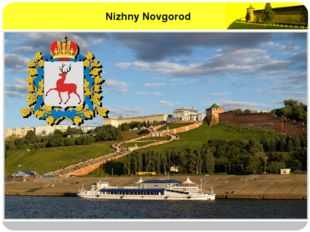
Nizhny Novgorod
2 слайд 
ABOUT THE CITY Nizhny Novgorod is one of the most beautiful and ancient Russian towns, beautifully located on Dyatlovy hills at the confluence of two big rivers, the Volga and the Oka. The Nizhny Novgorod of today is a big industrial, scientific and cultural center.
3 слайд 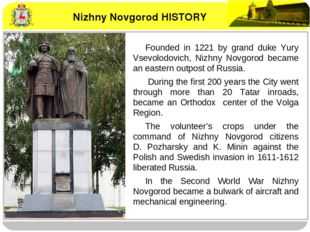
Nizhny Novgorod HISTORY Founded in 1221 by grand duke Yury Vsevolodovich, Nizhny Novgorod became an eastern outpost of Russia. During the first 200 years the City went through more than 20 Tatar inroads, became an Orthodox center of the Volga Region. The volunteer’s crops under the command of Nizhny Novgorod citizens D. Pozharsky and K. Minin against the Polish and Swedish invasion in 1611-1612 liberated Russia. In the Second World War Nizhny Novgorod became a bulwark of aircraft and mechanical engineering. 4 слайд 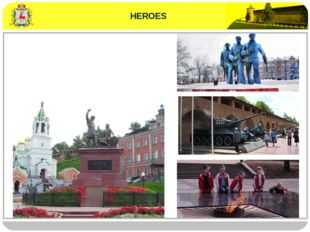
HEROES
5 слайд 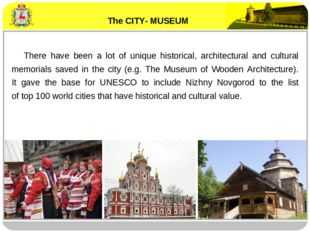
The CITY- MUSEUM There have been There have been a lot of unique historical, architectural and cultural memorials saved in the city (e.g. The Museum of Wooden Architecture). It gave the base for UNESCO to include Nizhny Novgorod to the list of top 100 world cities that have historical and cultural value.
6 слайд 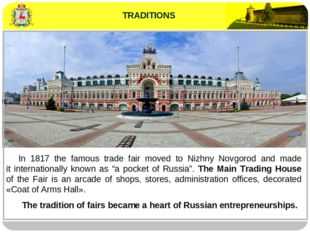
TRADITIONS In 1817 the famous trade fair moved to Nizhny Novgorod and made it internationally known as “a pocket of Russia”. The Main Trading House of the Fair is an arcade of shops, stores, administration offices, decorated «Coat of Arms Hall». The tradition of fairs became a heart of Russian entrepreneurships.
7 слайд 
CULTURE and ART There are many places to visit in Nizhny Novgorod: museums, exhibitions, concert halls, theaters, cinemas, parks, clubs and others.
8 слайд 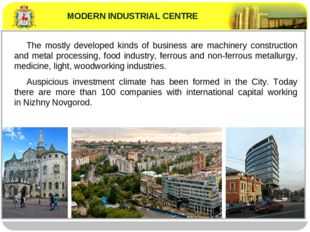
MODERN INDUSTRIAL CENTRE The mostly developed kinds of business are machinery construction and metal processing, food industry, ferrous and non-ferrous metallurgy, medicine, light, woodworking industries. Auspicious investment climate has been formed in the City. Today there are more than 100 companies with international capital working in Nizhny Novgorod.
9 слайд
Описание слайда:
At a HEIGHT Nizhny Novgorod aerial tramway is an alternative mean of passenger transport; the longest (3661 m) and the highest (57 m) in Europe.
Найдите материал к любому уроку,указав свой предмет (категорию), класс, учебник и тему:
Выберите категорию: Все категорииАлгебраАнглийский языкАстрономияБиологияВсемирная историяВсеобщая историяГеографияГеометрияДиректору, завучуДоп. образованиеДошкольное образованиеДругоеДругойЕстествознаниеИЗО, МХКИзобразительное искусствоИностранные языкиИнформатикаИскусствоИспанский языкИсторияИстория РоссииИстория Средних вековИтальянский языкКлассному руководителюКультурологияЛитератураЛитературное чтениеЛогопедияМатематикаМировая художественная культураМузыкаМХКНачальные классыНемецкий языкОБЖОбществознаниеОкружающий мирОсновы безопасности жизнедеятельностиПриродоведениеРелигиоведениеРисованиеРусский языкСоциальному педагогуТехнологияУкраинский языкФизикаФизическая культураФилософияФинский языкФранцузский языкХимияЧерчениеЧтениеШкольному психологуЭкология
Выберите класс: Все классыДошкольники1 класс2 класс3 класс4 класс5 класс6 класс7 класс8 класс9 класс10 класс11 класс
Выберите учебник: Все учебники
Выберите тему: Все темы
также Вы можете выбрать тип материала:
Общая информация
Номер материала: ДБ-260313
Похожие материалы
Оставьте свой комментарий
infourok.ru
Топик «My Native town Nizhny Novgorod» (материал для урока английского языка) — К уроку — Иностранные языки
My Native town Nizhny Novgorod
Everybody believes that his home town is an important place. Many interesting things can be said about Nizhny Novgorod its attractions and residents.
To begin with, Nizhny Novgorod is rather old. Over seven hundred years have passed since ancient tribes built a fortress on a high bank of the Oka River, where it joins the Volga. So, the city was founded in 1221, by Great Russian Prince Jury, a son of Vsevolod. Now it is one of the most beautiful Russian cities and a city of great national importance. It has a great population and is the third largest city in Russia.
Nizhny Novgorod has a rich history. In 1612 K. Minin and D. Pozharsky organized here people’s volunteer troops and made our Motherland free from Polish invaders. Nizhny Novgorod is the birthplace of Kulibin, a self-taught mechanical engineer, Lobachevsky, a mathematician, Melnikov-Pechorsky and M.Gorky, the writers. In 1932 the town was renamed Gorky, in honour and memory of the Great Russian writer, and in 1991 it got the name of Nizhny Novgorod again.
Nizhny Novgorod remembers Peter the great, Pushkin, Shevchenko, Chehov, Shalyapin, Saharov, who visited our city. In the past Nizhny Novgorod was an important commercial centre and the city of powerful merchant families. All Russian Trade Fair was held in Nizhny Novgorod for many years.
Nizhny Novgorod is well-known as a great industrial and transport centre of our country. There are many big factories in it. It is famous for the automobile plant and its cars. Shipbuilding is also developed in our city, a lot of ships for the Volga and other rivers are built here. In Nizhny Novgorod railroads, waterways and airlines meet. In 1985 a regular Metro traffic was added to this transport network.
My native town is a cultural and scientific centre as well. There are many theatres: the opera House, the Drama Theatre, the Puppet show, the Theatre of Young spectators, the Theatre of Comedy. You can also visit a lot of museums, the Art Gallery, cinemas and libraries.
The city is famous for its historical places. The most interesting are: Bolshaya Pokrovskaya Street with its beautiful buildings and the Kremlin with its ancient towers. A lot of gardens and parks make our city green and attractive. And the embankment of the Volga River is a fine place for a walk and a good rest.
My native town is beautiful in any season. I love it and I am proud to be its citizen.
pedsovet.su
Нижегородский кремль (на английском языке)
THE KREMLIN OF NIZHNY NOVGOROD
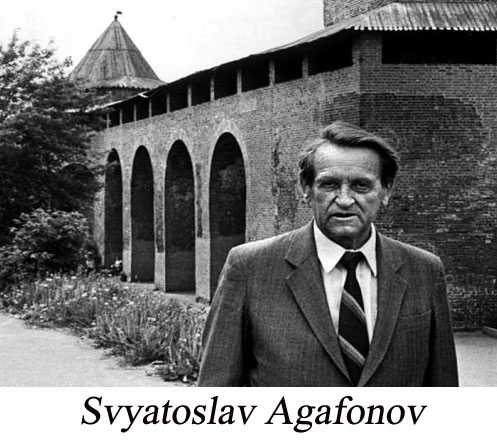
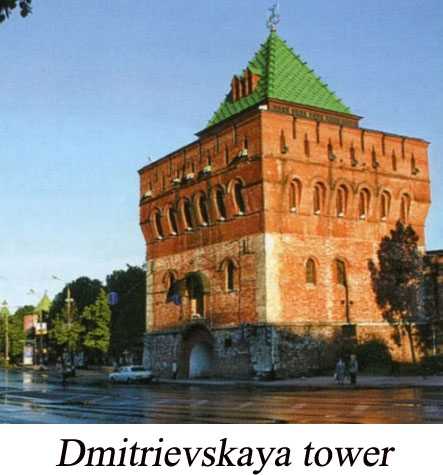
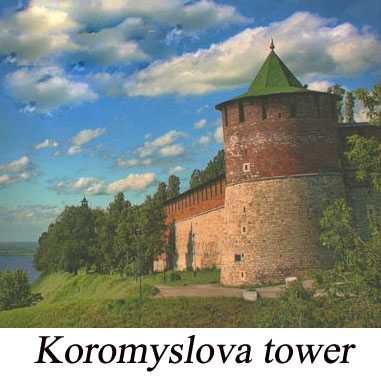
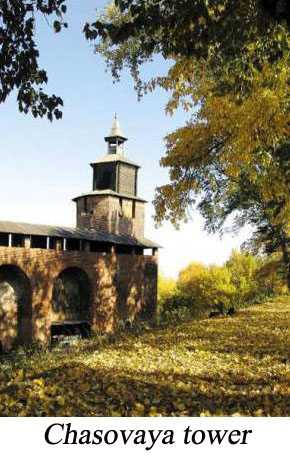
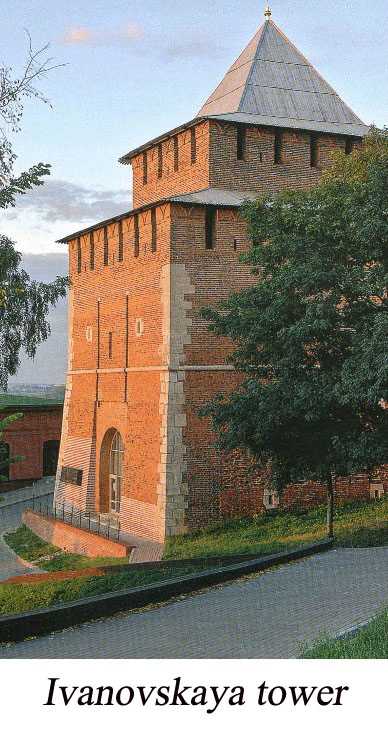
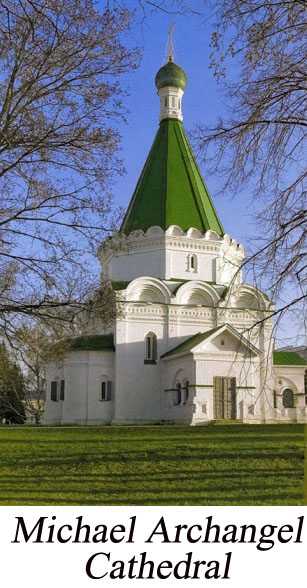
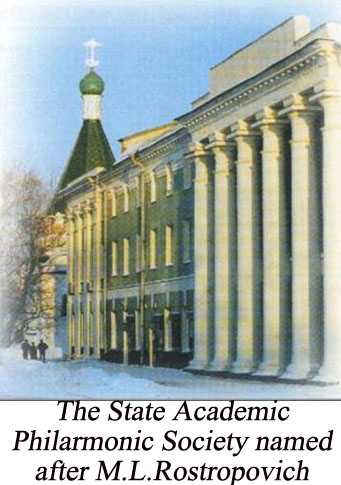
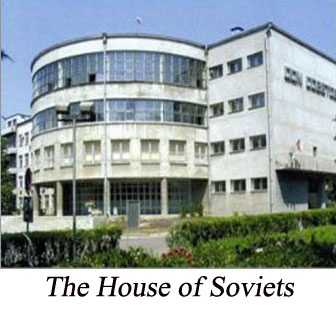
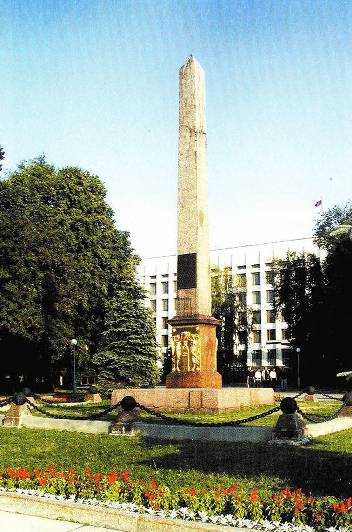
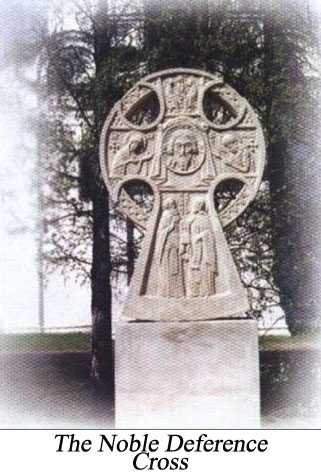
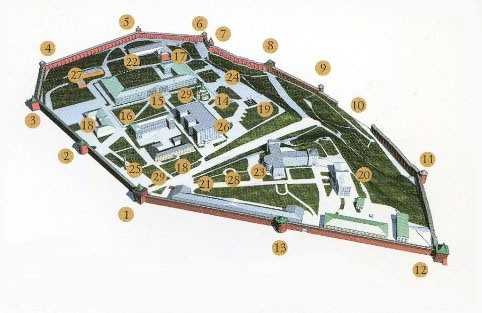
Towers: 1. Dmitrievskaya. 2. Kladovaya (Storage). 3. Nikolskaya. 4. Koromyslova (Yoke). 5. Tainitskaya (Secret). 6. Severnaya (North). 7. Chasovaya (Clock). 8. Ivanovskaya. 9. Belaya (White). 10. Zachatievskaya. 11. Borisoglebskaya. 12. Georgievskaya. 13. Porokhovaya (Gunpowder). 14. Archangel Cathedral. 15. A work-place’s building. (Cadet Corps). 16. The vice-governor’s houses. 17. The building of the Kremlin Police Unite. 18. The garnison baracks. 19. The obelisk in honour of Kozma Minin and Dmitry Pozharsky. 20. The palace of the military governor. 21. The building of the Arsenal. 22. The manege. 23. The House of Soviets. 24. The memorial complex. 25. The memorial «Gorkovites supporting the Army». 26. The seat of the regional committee of the C.P.S.U. 27. House of Goverment of Nizhny Novgorod region under construction. 28. The Noble Deference Cross. 29. The monument to the founder of Nizhny Novgorod, Prince Georgiy Vsevolodovich, and his spiritual mentor Saint Simon.
Назад
www.gorbibl.nnov.ru
Text 6 Nizhny Novgorod
Количество просмотров публикации Text 6 Nizhny Novgorod — 786
I. Read the letter and do the tasks following it.
Hi, Steve,
Here is the text about Nizhny Novgorod, my native place.
Nizhny Novgorod was founded in 1221. It is beautifully located on a number of hills, called the Dyatlov Hills in the name of the brigand, nicknamed Dyatel, who dominated the place in those days. The location offers a marvelous view from the river, which was noted in the past by high-ranking Russian and foreign guests, tsars, emperors, and also writers, historians and travellers. Actually, it is situated on 2 rivers – the Volga and the Oka. Its location is unique in that you can’t find anywhere else in Europe or in the world another city so highly placed at the confluence of two large rivers. It’s a pleasure to walk along the ancient Kremlin walls or along the embankments. In fact, these are my favourite walking routes. People with extrasensory abilities say that a walk along the Upper Volga embankment has a healing effect on the mind as well as on the body.
In the past, Nizhny Novgorod was famous for its world-known Fair which attracted Russians from all over the country, as well as foreigners from many parts of the world. It is Russia’s third largest city, formerly called “the pocket” and “the arsenal” of Russia. It played a crucial role in the salvation of the country from Polish invaders in the distant past and contributed greatly to the rout of the fascist Germany in World War II. A lot of tanks, airplanes, submarines and other armaments were manufactured at Gorky’s plants (after the October revolution Nizhny Novgorod was renamed in honour of the great proletarian writer Aleksey Peshkov, whose pen name was Maxim Gorky). It is known that Gorky was among the first Russian cities to be ruined completely by Hitler’s order in case Germany won a victory over Russia.
Nizhny Novgorod is a place of pilgrimage for lots of believers. It is known as the land of the great Russian saint, Serafim of Sarov, who is believed to be protecting the city and the whole of the country from disaster and ruin.
For me, Nizhny Novgorod is not just a great industrial, scientific and cultural centre neighbouring with the capital of the country. By modern standards, it is probably not the best place to live. Yet, I wouldn’t like to change it for any other place in the world.
I would be glad if you read my letter with interest.
I am looking forward to your answer.
With best wishes,
Alex.
II. Say if it is true or false.
1. Alex’s favourite walking route is the central street of the city.
2. At the time it was founded, Nizhny Novgorod was called Gorky.
3. Nizhny Novgorod is one of the largest cities of Russia.
4. Alex likes his city because it is a great scientific centre.
5. Nizhny Novgorod contributed greatly to the victory over fascism.
6. It played a decisive role in the rout of Polish and German invaders.
7. The city was earlier called “the pocket” and “the arsenal” of Russia.
III. Change the sentences using the words from the text.
Измените предложения, используя слова и выражения из текста.
1. After the revolution, Nizhny Novgorod was given the name of a famous Soviet writer.
2. Nizhny Novgorod is located on 2 large rivers.
3. A lot of armaments were produced at Gorky’s plants.
4. The monastery of Serafim of Sarov in Diveevo is often visited by believers.
5. In the past, Nizhny Novgorod was well-known for its popular Fair.
6. Nizhny Novgorod is not far from the capital of the country.
7. Alex wouldn’t like to live in any other city.
referatwork.ru
Составь рассказ «Мой родной город».. Желательно про Нижний…
Nizhny Novgorod is the fourth largest city in Russia, ranking after Moscow, St. Petersburg, and Novosibirsk. It is the economic and cultural center of the vast Volga-Vyatka economic region, and also the administrative center of Nizhny Novgorod Oblast and Volga Federal District. From 1932 to 1990, the city was known as Gorky after the writer Maxim Gorky who was born there. The city is an important economic, transport and cultural center of the Russian Federation. After the destruction of the Mordvin Inazor Obram administrative centre and fillfort named Obran Osh (Ashli) at the site of future stone Kremlin in 1220, a small Russian wooden hillfort was founded by Grand Duke Yuri II of Russia in 1221. Located at the confluence of two most important rivers of his principality, the Volga and the Oka, and Obran Osh was renamed Nizhny Novgorod. Its name literally means Lower Newtown, to distinguish it from the older Veliky Novgorod. Its independent existence was threatened by the continuous Mordvin attacks against it. The major attempt made by Inazor Purgaz from Arzamas in January 1229 was repulsed, but after the death of Yuri II on March 4, 1238 at the Battle of Sit River the Mongols occupied the fortress and the remnants of small Nizhny Novgorod settlement which surrendered without any resistance in order to preserve what had been developed since Purgazs attack eight years earlier. Later a major stronghold for border protection, Nizhny Novgorod fortress took advantage of a natural moat formed by the two rivers. Along with Moscow and Tver, Nizhny Novgorod was among several newly-founded towns that escaped Mongol devastation on account of their insignificance, but grew into (great) centers in vassalic Russian political life during the period of the Tatar Yoke. With the agreement of the Mongol Khan, Nizhny Novgorod was incorporated into the Vladimir — Suzdal Principality in 1264. After 86 years its importance further increased when the seat of the powerful Suzdal Principality was moved here from Gorodets in 1350. Grand Duke Dmitry Konstantinovich (1323–1383) sought to make his capital a rival worthy of Moscow; he built a stone citadel and several churches and was a patron of historians. The earliest extant manuscript of the Russian Primary Chronicle, the Laurentian Codex, was written for him by the local monk Laurentius in 1337. (Извини что такой длинный…)
Оцени ответ
napyaterku.com
метки: Новгород, Нижний, Английский, Перевод, Краткий, Monument, Orthodox, Город
Топик «My Native town Nizhny Novgorod» (материал для урока английского языка)
Everybody believes that his home town is an important place. Many interesting things can be said about Nizhny Novgorod its attractions and residents.
To begin with, Nizhny Novgorod is rather old. Over seven hundred years have passed since ancient tribes built a fortress on a high bank of the Oka River, where it joins the Volga. So, the city was founded in 1221, by Great Russian Prince Jury, a son of Vsevolod. Now it is one of the most beautiful Russian cities and a city of great national importance. It has a great population and is the third largest city in Russia.
Nizhny Novgorod has a rich history. In 1612 K. Minin and D. Pozharsky organized here people’s volunteer troops and made our Motherland free from Polish invaders. Nizhny Novgorod is the birthplace of Kulibin, a self-taught mechanical engineer, Lobachevsky, a mathematician, Melnikov-Pechorsky and M.Gorky, the writers. In 1932 the town was renamed Gorky, in honour and memory of the Great Russian writer, and in 1991 it got the name of Nizhny Novgorod again.
Nizhny Novgorod remembers Peter the great, Pushkin, Shevchenko, Chehov, Shalyapin, Saharov, who visited our city. In the past Nizhny Novgorod was an important commercial centre and the city of powerful merchant families. All Russian Trade Fair was held in Nizhny Novgorod for many years.
Nizhny Novgorod is well-known as a great industrial and transport centre of our country. There are many big factories in it. It is famous for the automobile plant and its cars. Shipbuilding is also developed in our city, a lot of ships for the Volga and other rivers are built here. In Nizhny Novgorod railroads, waterways and airlines meet. In 1985 a regular Metro traffic was added to this transport network.
My native town is a cultural and scientific centre as well. There are many theatres: the opera House, the Drama Theatre, the Puppet show, the Theatre of Young spectators, the Theatre of Comedy. You can also visit a lot of museums, the Art Gallery, cinemas and libraries.
The city is famous for its historical places. The most interesting are: Bolshaya Pokrovskaya Street with its beautiful buildings and the Kremlin with its ancient towers. A lot of gardens and parks make our city green and attractive. And the embankment of the volga river is a fine place for a walk and a good rest.
10 стр., 4540 слов
Топик great britain | великобритания на английском языке
… Великобританией, Англией и Соединенным Королевством. Топик по английскому «Великобритания» (Great Britain) The United Kingdom of Great … железа и стали. Наиболее важные промышленные города Великобритании – это Лондон, Бирмингэм, Манчестер, Глазго, … goods. The most important industrial cities of Great Britain are London, Birmingham, Manchester, … население в 60 млн. человек на территории 244 тыс. кв. км. …
My native town is beautiful in any season. I love it and I am proud to be its citizen.
Рассказ о Новгороде
Novgorod is one of the ancient cities in Russian Federation. There is a great number of monuments, museums and other places of interest on the territory of Novgorod. Novgorod was founded in 859 AD on the Volkhov River not far from the Ilmen Lake. It is considered that the history of Russian statehood has begun from this place. The city history is closely connected with the main periods of development and life of Russia. In 862 this city became the first capital of Rus but later the capital was moved to Kiev by Vladimir the Great. In those days Novgorod was playing a key role in expanding of culture and literacy in Russia. Almost all citizens of the city were educated. Novgorod was not only a cultural center but it was also a reliable fortress protecting Russian borders. During Tatar and Mongol invasion Novgorod didn’t suffer thereby it kept its unique ancient Russian architecture which is now attracting tourists from all over the world.
In the 21th century Novgorod is an important port and railway hub. The city has modern infrastructure: hotels, schools, universities, restaurants, parks and shopping malls. There is an airport in the city. The city is attractive for the tourists who would like to visit monuments of ancient Russia. It is famous for its kremlin, Monument devoted to Millennium of Russia, orthodox churches, archaeological sites.
The Kremlin was first mentioned in the chronicle in 1044. It is situated on the hill over the Volkhov River. At first the Kremlin was wooden and it has burnt down several times. The Kremlin was built of stone in 1430. There are 3 churches and 9 towers within the Kremlin.
Construction of Saint Sophia’s cathedral started in 1045 on the Kremlin territory. The Cathedral was constructed in the byzantine style and had 6 domes. Nowadays it is the main Orthodox Church in Novgorod.
Millennium of Russia monument was built in the city in 1862. It represents a giant bell with the bas-reliefs showing various details of Russian history. At the top of the monument there is a woman down on her knees representing Russia and an angel with a cross in his hand.
Nowadays population of Novgorod is equal to approximately 220 000 people. Chemical, food, wood-working, mechanical engineering, metal processing and electrical industries are successfully developed in Novgorod. The city is one of Russian touristic centres. They say that to know Russia one should visit Novgorod. Do visit it as soon as you have such a chance.
Новгород является одним из древних городов в Российской Федерации. На территории находится большое количество памятников, музеев и других достопримечательностей. Город был основан около реки Волхов, рядом с озером Ильмень в 859 г. Считается, что с этого места началась история российского государства. История города связана с основными периодами развития и жизни России. В 862 году Новгород стал первой столицей Руси, которая позже была перенесена в Киев Владимиром Великим. В те времена Новгород играл огромную роль в распространении культуры и грамотности. Практически все население города было образованным. Он был не только культурным центром, но и надежной крепостью, защищавшей русские рубежи. Во время татаро-монгольского ига Новгород не пострадал от монгольского нашествия, тем самым сохранил уникальную древнерусскую архитектуру, которая привлекает туристов со всего мира.
4 стр., 1935 слов
Английский ( Топики/Сочинения ): Sport in Russia — Спорт в России
… похожий вид спорта — воздушный сёрфинг. В этом случае человек выпрыгивает из самолёта, который летит на высоте около 5 километров, и скользит по воздуху на специальной доске. В России существует … 14. What is the most popular sports game in Russia? 15. Can you name any famous Russian football clubs? Vocabulary: description — определение competitive — сопернический entertaining — развлекательный …
В 21 веке Новгород является важным портом и железнодорожным узлом. Город обладает современной инфраструктурой: гостиницы, школы, университеты, рестораны, парки и торговые центры. В городе расположен аэропорт. Город привлекателен для туристов, которые желают познакомиться с памятниками Древней Руси. На территории Великого Новгорода размещён кремль, знаменитый памятник посвящённый Тысячелетию Руси, православные храмы, места археологических раскопок.
Кремль впервые упоминается в летописи в 1044 году. Он расположен на холме над рекой Волхов. Первоначально кремль был деревянным и горел несколько раз. Каменный кремль был построен в 1430 годах. В кремле есть 3 храма, 9 башен
В 1045 году началось возведение Софийского собора на территории кремля. Собор выполнен в византийском стиле и имеет 6 куполов. Он является главным православным храмом.
Памятник Тысячелетия Руси построен в Новгороде в 1862 году. Он представляет собой гигантский колокол с барельефами, отражающими разные фрагменты российской истории. На вершине монумента изображена коленопреклоненная женщина, олицетворяющая Россию и ангел с крестом в руке.
В настоящее время численность населения примерно равна 220 000 человек.
В Новгороде развивается химическая, пищевая, деревообрабатывающая, машиностроительная и металлообрабатывающая, электротехническая промышленность. Город является одним из туристических центров России.
Говорят, что для того, чтобы узнать Россию, нужно побывать в Новгороде. Обязательно сделайте это, как только у вас появится такая возможность.
Материал подготовлен нашими репетиторами английского по скайпу. Первый урок бесплатный в рамках 30 минут.
Nizhny Novgorod
Nizhny Novgorod is a city in the European part of Russia located in the confluence of the Oka and the Volga rivers. The city was established in 1221 and is located 400 km away fr om Moscow. One of the most ancient cities of trade and handicrafts in Russia.
Nizhny Novgorod Is a City with Centuries-Long History
The Nizhny Novgorod Kremlin is the main attraction of the city and something it is rightly proud of. The Kremlin was built at the beginning of the sixteenth century as a military fortress. Nowadays, this unique open-air museum is not only a popular destination for regular guided tours, but also for special tours with elements of stage shows and quests. Rozhdestvenskaya Street is one of the central streets of the city where you can still see houses of the mid-18th/19th centuries. A walk along Rozhdestvenskaya Street is a guaranteed way to get in the perfect mood and become immersed into the atmosphere of the past.
9 стр., 4292 слов
На английском языке Где лучше жить: в городе или в деревне?/ …
… приеду в гости. Я очень по ним скучаю. Сочинение на тему моя деревня на английском языке Copyright © Russian centres of City and Guilds Культурная жизнь И … -то в деревне и у меня была красивая и … Где лучше жить: в городе или в деревне Многие люди часто обсуждают эту тему: где жизнь лучше в городе или в деревне? Моя семья жила когда …
City of Literature
Nizhny Novgorod is where Maxim Gorky (1868–1936), one of the world’s best known Russian writers, spent his childhood. In 1932, the city was renamed in honour of this renowned writer. In 1990, however, Nizhny Novgorod returned its initial name. The State Gorky Literature Museum, with an exhibit of over 100,000 items, is now located in Nizhny Novgorod. Incidentally, Gorky’s saying, «Learn fr om everyone, copy nobody» is a motto of the Study in Russia project.
City of Multiple Religions
There are over 120 religious communities and societies in Nizhny Novgorod, including those for followers of Orthodox, Muslim, Jewish, Evangelistic, Lutheran, Buddhist, and other religions. The majority of local cathedrals are Orthodox, there’s a mosque, a synagogue, and centres of other religious communities.
City of Art
There is a number of fascinating objets d’art and galleries in Nizhny Novgorod. The Blogger’s Bench is a monument to the Russian blogosphere. The monument looks like two benches in the form of notebooks joined by the @ Internet sign. The site is large enough for 10 people and is equipped with free Wi-Fi. The Kladovka Art Gallery is located in the city centre and hosts concerts, master classes, entertainment events, shows of local theatres and art exhibitions of local talents. Those who love experiences would love visiting the Upside Down House entertainment museum which is literally a house turned on its head.
City of Music
People in Nizhny love rock music and rock musicians. There are a number of places here wh ere fantastic concerts are staged. There are cafes offering live music, including jazz. Famous Russian musicians and DJs are frequent visitors of Nizhny Novgorod, be it for a concert, festival, or even a Halloween party. There is a number of sites for such parties in Nizhny. Markus Schulz, Tito & Tarantula, Garbage, Scooter, Emika, Kosheen, Okean Elzy, Aria, Kipelov, Alisa, Ivan Dorn, TIMATI, Kasta, Lumen, Basta, Mumiy Troll, Noize MC are just some of many performers that have visited Nizhny Novgorod with concerts.
Near the City
There are many spots in the suburbs of Nizhny Novgorod that are worth visiting, including multiple lakes. The biggest lake is the Svetloyar which is mentioned in the legend about the «Russian Atlantis» – the town Kitezh that drowned in the 18th century. This water body has an ideal oval shape and crystal clear water. It is over 33 metres deep.
Over one thousand caves, chasms, rocks, craters, and grottos are located in the Ichalkovsky Pinewood – a protected forest, 170 km away from Nizhny Novgorod. Some of these caves contain concealed lakes. There are special guided tours, and you can even head off on your own adventure.
A cable railway connecting Nizhny Novgorod with the town of Bor was opened in 2002. The transportation system, initially launched to relieve passenger flow, has quickly become one of the main forms of entertainment for locals and visitors of the city.
6 стр., 2749 слов
Урок английского языка «Should cars be banned from the city centers?»
… fire engines find it difficult to fulfil their duties. For this reason cars should be banned from city centres. — That’s right. I also think so. That will reduce traffic jams and … and can cause worse diseases you can get to shopping centres which are built outside towns cars contribute to global warming and acid rains VII. Post-reading …
There’s a museum in the productive mine of the Peshelansky Gypsum Plant (approximately 120 km away from Nizhny) wh ere visitors can descend 70 meters underground. They are also offered miner’s coats, helmets, and lights, and shown how gypsum is produced today and in the past.
The Pushkin Reserve Museum is in Bolshoe Boldino village, 230 km away from Nizhny Novgorod. Previously, here was the manor owned by the family of the poet for several centuries. Alexander Sergeevich liked to spend autumn months in the family estate – enjoying the beauty of Russian nature, wrote poetry and prose.
There is a town of Semenov in the Nizhny Novgorod region – the homeland of Khokhloma painting. Tours are organized for students to the factory producing Matryoshka (Russian nesting dolls), master classes are held.
You can learn more about the folk arts and crafts in Gorodets – the old Russian town on the Volga River. There is a museum and tourist complex “Town of Masters” with the expositions devoted to painting, embroidery, toys, wood carving, gingerbread making and pottery.
Составь рассказ «Мой родной город».. Желательно про Нижний Новгород!!! Достопримечательности нижнего новгорода на английском языке с переводом
Тема Нижний Новгород на английском языке: достопримечательности, рассказ о городе
Нижний Новгород — город множества достопримечательностей.
Nizhny Novgorod Kremlin – Нижегородский Кремль
- The center and the heart of the city – центр и сердце города
- The city authorities – городская власть
- The region governor administration – администрация губернатора области
- The legislation authorities – законодательная власть
The Kremlin is the center and the heart of the city. It’s the place where the history of Nizhny Novgorod started.Nizhny Novgorod Kremlin includes 5 square towers with the gates and 8 round ones.The city authorities, the region governor administration and the legislation authorities are situated inside the Kremlin walls. Moreover, there are religion and cultural sights such as Mikhaylo-Arkhangelsky Cathedral, Eternal Flame and museums.
Nizhny Novgorod Fair– Нижегородская ярмарка
- Famous exhibition center – известный выставочный центр
- Market place – ярмарочное место
- Superb modern exhibition complex – превосходный современный выставочный комплекс
Founded ages ago now Nizhny Novgorod Fair is both a great historical and architectural tourist attraction and a famous exhibition center.Nizhny Novgorod Fair has a great history. Actually it was a market place but after renovating the fair has become a superb modern exhibition complex that now welcomes different international events, fairs, and conventions.
Nizhny Novgorod State Art Museum Rukavishnikov Mansion– Нижегородский государственный художественный музей
- The City Art and Historical Museum – городской художественный и исторический музей
- Gain a great history – обрести великую историю
- Diverse and rich collection of paintings – разнообразная и богатая коллекция картин
- Masterpieces — шедевры
The Nizhny Novgorod State Art Museum is one of the oldest museums in Russia. Being founded in 1896 as «The City Art and Historical Museum» it has gained a great history and now has got a diverse and rich collection of paintings of different trend and genre. There are masterpieces both of Russian and European painters.
Rukavishnikov Mansion – Усадьба Рукавишниковых
- This exhibition space – выставочное пространство
- Mansion — усадьба
- Illustrious interior – знаменитый ресторан
This exhibition space is located inside a 19th-century mansion once belonging to the Rukavishnikov merchant family. There you can wander through the rooms on your own or join one of the hourly 40-minute excursions in Russian and English. Furniture and the interior are illustrious.
Chkalov Staircase – Чкаловская лестница
- A monumental erection of the Soviet era — монументальное сооружение советской эпохи
- Derive its name – получить свое название
- At the top of the stairs — в верхней части лестницы
- An immense sum — огромные деньги
- The river embankment — набережная реки
- Flight of stairs – лестничный пролет
The Chkalov Staircase is a great and monumental erection built in the Soviet era. The construction of the staircase cost an immense sum at the time – almost 8 million rubles and was built by German prisoners of the war. The staircase derives its name from pilot Valery Chkalov. He was the first man who flew from Moscow to Vancouver through the North Pole in 1937. There is a monument to Chkalov at the top of the stairs. Staircase numbers at about 1,500 stairs that connect the river embankment with the city center.
Подписывайтесь на бесплатный курс английского языка по e-mail.Тематические топики, видео и советы по обучению. Учите язык удобно.
150slov.com
Рассказ о Новгороде на английском (тема, топик с переводом)
Novgorod is one of the ancient cities in Russian Federation. There is a great number of monuments, museums and other places of interest on the territory of Novgorod. Novgorod was founded in 859 AD on the Volkhov River not far from the Ilmen Lake. It is considered that the history of Russian statehood has begun from this place. The city history is closely connected with the main periods of development and life of Russia. In 862 this city became the first capital of Rus but later the capital was moved to Kiev by Vladimir the Great. In those days Novgorod was playing a key role in expanding of culture and literacy in Russia. Almost all citizens of the city were educated. Novgorod was not only a cultural center but it was also a reliable fortress protecting Russian borders. During Tatar and Mongol invasion Novgorod didn’t suffer thereby it kept its unique ancient Russian architecture which is now attracting tourists from all over the world.
In the 21th century Novgorod is an important port and railway hub. The city has modern infrastructure: hotels, schools, universities, restaurants, parks and shopping malls. There is an airport in the city. The city is attractive for the tourists who would like to visit monuments of ancient Russia. It is famous for its Kremlin, Monument devoted to Millennium of Russia, orthodox churches, archaeological sites.
The Kremlin was first mentioned in the chronicle in 1044. It is situated on the hill over the Volkhov River. At first the Kremlin was wooden and it has burnt down several times. The Kremlin was built of stone in 1430. There are 3 churches and 9 towers within the Kremlin.
Construction of Saint Sophia’s cathedral started in 1045 on the Kremlin territory. The Cathedral was constructed in the byzantine style and had 6 domes. Nowadays it is the main Orthodox Church in Novgorod.
Millennium of Russia monument was built in the city in 1862. It represents a giant bell with the bas-reliefs showing various details of Russian history. At the top of the monument there is a woman down on her knees representing Russia and an angel with a cross in his hand.
Nowadays population of Novgorod is equal to approximately 220 000 people. Chemical, food, wood-working, mechanical engineering, metal processing and electrical industries are successfully developed in Novgorod. The city is one of Russian touristic centres. They say that to know Russia one should visit Novgorod. Do visit it as soon as you have such a chance.
Перевод
Новгород является одним из древних городов в Российской Федерации. На территории находится большое количество памятников, музеев и других достопримечательностей. Город был основан около реки Волхов, рядом с озером Ильмень в 859 г. Считается, что с этого места началась история российского государства. История города связана с основными периодами развития и жизни России. В 862 году Новгород стал первой столицей Руси, которая позже была перенесена в Киев Владимиром Великим. В те времена Новгород играл огромную роль в распространении культуры и грамотности. Практически все население города было образованным. Он был не только культурным центром, но и надежной крепостью, защищавшей русские рубежи. Во время татаро-монгольского ига Новгород не пострадал от монгольского нашествия, тем самым сохранил уникальную древнерусскую архитектуру, которая привлекает туристов со всего мира.
В 21 веке Новгород является важным портом и железнодорожным узлом. Город обладает современной инфраструктурой: гостиницы, школы, университеты, рестораны, парки и торговые центры. В городе расположен аэропорт. Город привлекателен для туристов, которые желают познакомиться с памятниками Древней Руси. На территории Великого Новгорода размещён кремль, знаменитый памятник посвящённый Тысячелетию Руси, православные храмы, места археологических раскопок.
Кремль впервые упоминается в летописи в 1044 году. Он расположен на холме над рекой Волхов. Первоначально кремль был деревянным и горел несколько раз. Каменный кремль был построен в 1430 годах. В кремле есть 3 храма, 9 башен
В 1045 году началось возведение Софийского собора на территории кремля. Собор выполнен в византийском стиле и имеет 6 куполов. Он является главным православным храмом.
Памятник Тысячелетия Руси построен в Новгороде в 1862 году. Он представляет собой гигантский колокол с барельефами, отражающими разные фрагменты российской истории. На вершине монумента изображена коленопреклоненная женщина, олицетворяющая Россию и ангел с крестом в руке.
В настоящее время численность населения примерно равна 220 000 человек.
В Новгороде развивается химическая, пищевая, деревообрабатывающая, машиностроительная и металлообрабатывающая, электротехническая промышленность. Город является одним из туристических центров России.
Говорят, что для того, чтобы узнать Россию, нужно побывать в Новгороде. Обязательно сделайте это, как только у вас появится такая возможность.
Материал подготовлен нашими репетиторами английского по скайпу. Первый урок бесплатный в рамках 30 минут.
online-teacher.ru
Презентация по английскому языку «Nizhniy Novgorod»
Описание презентации по отдельным слайдам:
1 слайд 
Nizhny Novgorod
2 слайд 
ABOUT THE CITY Nizhny Novgorod is one of the most beautiful and ancient Russian towns, beautifully located on Dyatlovy hills at the confluence of two big rivers, the Volga and the Oka. The Nizhny Novgorod of today is a big industrial, scientific and cultural center.
3 слайд 
Nizhny Novgorod HISTORY Founded in 1221 by grand duke Yury Vsevolodovich, Nizhny Novgorod became an eastern outpost of Russia. During the first 200 years the City went through more than 20 Tatar inroads, became an Orthodox center of the Volga Region. The volunteer’s crops under the command of Nizhny Novgorod citizens D. Pozharsky and K. Minin against the Polish and Swedish invasion in 1611-1612 liberated Russia. In the Second World War Nizhny Novgorod became a bulwark of aircraft and mechanical engineering. 4 слайд 
HEROES
5 слайд 
The CITY- MUSEUM There have been There have been a lot of unique historical, architectural and cultural memorials saved in the city (e.g. The Museum of Wooden Architecture). It gave the base for UNESCO to include Nizhny Novgorod to the list of top 100 world cities that have historical and cultural value.
6 слайд 
TRADITIONS In 1817 the famous trade fair moved to Nizhny Novgorod and made it internationally known as “a pocket of Russia”. The Main Trading House of the Fair is an arcade of shops, stores, administration offices, decorated «Coat of Arms Hall». The tradition of fairs became a heart of Russian entrepreneurships.
7 слайд 
CULTURE and ART There are many places to visit in Nizhny Novgorod: museums, exhibitions, concert halls, theaters, cinemas, parks, clubs and others.
8 слайд 
MODERN INDUSTRIAL CENTRE The mostly developed kinds of business are machinery construction and metal processing, food industry, ferrous and non-ferrous metallurgy, medicine, light, woodworking industries. Auspicious investment climate has been formed in the City. Today there are more than 100 companies with international capital working in Nizhny Novgorod.
9 слайд
Описание слайда:
At a HEIGHT Nizhny Novgorod aerial tramway is an alternative mean of passenger transport; the longest (3661 m) and the highest (57 m) in Europe.
Найдите материал к любому уроку,указав свой предмет (категорию), класс, учебник и тему:
Выберите категорию: Все категорииАлгебраАнглийский языкАстрономияБиологияВсемирная историяВсеобщая историяГеографияГеометрияДиректору, завучуДоп. образованиеДошкольное образованиеДругоеДругойЕстествознаниеИЗО, МХКИзобразительное искусствоИностранные языкиИнформатикаИскусствоИспанский языкИсторияИстория РоссииИстория Средних вековИтальянский языкКлассному руководителюКультурологияЛитератураЛитературное чтениеЛогопедияМатематикаМировая художественная культураМузыкаМХКНачальные классыНемецкий языкОБЖОбществознаниеОкружающий мирОсновы безопасности жизнедеятельностиПриродоведениеРелигиоведениеРисованиеРусский языкСоциальному педагогуТехнологияУкраинский языкФизикаФизическая культураФилософияФинский языкФранцузский языкХимияЧерчениеЧтениеШкольному психологуЭкология
Выберите класс: Все классыДошкольники1 класс2 класс3 класс4 класс5 класс6 класс7 класс8 класс9 класс10 класс11 класс
Выберите учебник: Все учебники
Выберите тему: Все темы
также Вы можете выбрать тип материала:
Общая информация
Номер материала: ДБ-260313
Похожие материалы
Оставьте свой комментарий
infourok.ru
Топик «My Native town Nizhny Novgorod» (материал для урока английского языка) — К уроку — Иностранные языки
My Native town Nizhny Novgorod
Everybody believes that his home town is an important place. Many interesting things can be said about Nizhny Novgorod its attractions and residents.
To begin with, Nizhny Novgorod is rather old. Over seven hundred years have passed since ancient tribes built a fortress on a high bank of the Oka River, where it joins the Volga. So, the city was founded in 1221, by Great Russian Prince Jury, a son of Vsevolod. Now it is one of the most beautiful Russian cities and a city of great national importance. It has a great population and is the third largest city in Russia.
Nizhny Novgorod has a rich history. In 1612 K. Minin and D. Pozharsky organized here people’s volunteer troops and made our Motherland free from Polish invaders. Nizhny Novgorod is the birthplace of Kulibin, a self-taught mechanical engineer, Lobachevsky, a mathematician, Melnikov-Pechorsky and M.Gorky, the writers. In 1932 the town was renamed Gorky, in honour and memory of the Great Russian writer, and in 1991 it got the name of Nizhny Novgorod again.
Nizhny Novgorod remembers Peter the great, Pushkin, Shevchenko, Chehov, Shalyapin, Saharov, who visited our city. In the past Nizhny Novgorod was an important commercial centre and the city of powerful merchant families. All Russian Trade Fair was held in Nizhny Novgorod for many years.
Nizhny Novgorod is well-known as a great industrial and transport centre of our country. There are many big factories in it. It is famous for the automobile plant and its cars. Shipbuilding is also developed in our city, a lot of ships for the Volga and other rivers are built here. In Nizhny Novgorod railroads, waterways and airlines meet. In 1985 a regular Metro traffic was added to this transport network.
My native town is a cultural and scientific centre as well. There are many theatres: the opera House, the Drama Theatre, the Puppet show, the Theatre of Young spectators, the Theatre of Comedy. You can also visit a lot of museums, the Art Gallery, cinemas and libraries.
The city is famous for its historical places. The most interesting are: Bolshaya Pokrovskaya Street with its beautiful buildings and the Kremlin with its ancient towers. A lot of gardens and parks make our city green and attractive. And the embankment of the Volga River is a fine place for a walk and a good rest.
My native town is beautiful in any season. I love it and I am proud to be its citizen.
pedsovet.su
Нижегородский кремль (на английском языке)
THE KREMLIN OF NIZHNY NOVGOROD











Towers: 1. Dmitrievskaya. 2. Kladovaya (Storage). 3. Nikolskaya. 4. Koromyslova (Yoke). 5. Tainitskaya (Secret). 6. Severnaya (North). 7. Chasovaya (Clock). 8. Ivanovskaya. 9. Belaya (White). 10. Zachatievskaya. 11. Borisoglebskaya. 12. Georgievskaya. 13. Porokhovaya (Gunpowder). 14. Archangel Cathedral. 15. A work-place’s building. (Cadet Corps). 16. The vice-governor’s houses. 17. The building of the Kremlin Police Unite. 18. The garnison baracks. 19. The obelisk in honour of Kozma Minin and Dmitry Pozharsky. 20. The palace of the military governor. 21. The building of the Arsenal. 22. The manege. 23. The House of Soviets. 24. The memorial complex. 25. The memorial «Gorkovites supporting the Army». 26. The seat of the regional committee of the C.P.S.U. 27. House of Goverment of Nizhny Novgorod region under construction. 28. The Noble Deference Cross. 29. The monument to the founder of Nizhny Novgorod, Prince Georgiy Vsevolodovich, and his spiritual mentor Saint Simon.
Назад
www.gorbibl.nnov.ru
Text 6 Nizhny Novgorod
Количество просмотров публикации Text 6 Nizhny Novgorod — 786
I. Read the letter and do the tasks following it.
Hi, Steve,
Here is the text about Nizhny Novgorod, my native place.
Nizhny Novgorod was founded in 1221. It is beautifully located on a number of hills, called the Dyatlov Hills in the name of the brigand, nicknamed Dyatel, who dominated the place in those days. The location offers a marvelous view from the river, which was noted in the past by high-ranking Russian and foreign guests, tsars, emperors, and also writers, historians and travellers. Actually, it is situated on 2 rivers – the Volga and the Oka. Its location is unique in that you can’t find anywhere else in Europe or in the world another city so highly placed at the confluence of two large rivers. It’s a pleasure to walk along the ancient Kremlin walls or along the embankments. In fact, these are my favourite walking routes. People with extrasensory abilities say that a walk along the Upper Volga embankment has a healing effect on the mind as well as on the body.
In the past, Nizhny Novgorod was famous for its world-known Fair which attracted Russians from all over the country, as well as foreigners from many parts of the world. It is Russia’s third largest city, formerly called “the pocket” and “the arsenal” of Russia. It played a crucial role in the salvation of the country from Polish invaders in the distant past and contributed greatly to the rout of the fascist Germany in World War II. A lot of tanks, airplanes, submarines and other armaments were manufactured at Gorky’s plants (after the October revolution Nizhny Novgorod was renamed in honour of the great proletarian writer Aleksey Peshkov, whose pen name was Maxim Gorky). It is known that Gorky was among the first Russian cities to be ruined completely by Hitler’s order in case Germany won a victory over Russia.
Nizhny Novgorod is a place of pilgrimage for lots of believers. It is known as the land of the great Russian saint, Serafim of Sarov, who is believed to be protecting the city and the whole of the country from disaster and ruin.
For me, Nizhny Novgorod is not just a great industrial, scientific and cultural centre neighbouring with the capital of the country. By modern standards, it is probably not the best place to live. Yet, I wouldn’t like to change it for any other place in the world.
I would be glad if you read my letter with interest.
I am looking forward to your answer.
With best wishes,
Alex.
II. Say if it is true or false.
1. Alex’s favourite walking route is the central street of the city.
2. At the time it was founded, Nizhny Novgorod was called Gorky.
3. Nizhny Novgorod is one of the largest cities of Russia.
4. Alex likes his city because it is a great scientific centre.
5. Nizhny Novgorod contributed greatly to the victory over fascism.
6. It played a decisive role in the rout of Polish and German invaders.
7. The city was earlier called “the pocket” and “the arsenal” of Russia.
III. Change the sentences using the words from the text.
Измените предложения, используя слова и выражения из текста.
1. After the revolution, Nizhny Novgorod was given the name of a famous Soviet writer.
2. Nizhny Novgorod is located on 2 large rivers.
3. A lot of armaments were produced at Gorky’s plants.
4. The monastery of Serafim of Sarov in Diveevo is often visited by believers.
5. In the past, Nizhny Novgorod was well-known for its popular Fair.
6. Nizhny Novgorod is not far from the capital of the country.
7. Alex wouldn’t like to live in any other city.
referatwork.ru
Составь рассказ «Мой родной город».. Желательно про Нижний…
Nizhny Novgorod is the fourth largest city in Russia, ranking after Moscow, St. Petersburg, and Novosibirsk. It is the economic and cultural center of the vast Volga-Vyatka economic region, and also the administrative center of Nizhny Novgorod Oblast and Volga Federal District. From 1932 to 1990, the city was known as Gorky after the writer Maxim Gorky who was born there. The city is an important economic, transport and cultural center of the Russian Federation. After the destruction of the Mordvin Inazor Obram administrative centre and fillfort named Obran Osh (Ashli) at the site of future stone Kremlin in 1220, a small Russian wooden hillfort was founded by Grand Duke Yuri II of Russia in 1221. Located at the confluence of two most important rivers of his principality, the Volga and the Oka, and Obran Osh was renamed Nizhny Novgorod. Its name literally means Lower Newtown, to distinguish it from the older Veliky Novgorod. Its independent existence was threatened by the continuous Mordvin attacks against it. The major attempt made by Inazor Purgaz from Arzamas in January 1229 was repulsed, but after the death of Yuri II on March 4, 1238 at the Battle of Sit River the Mongols occupied the fortress and the remnants of small Nizhny Novgorod settlement which surrendered without any resistance in order to preserve what had been developed since Purgazs attack eight years earlier. Later a major stronghold for border protection, Nizhny Novgorod fortress took advantage of a natural moat formed by the two rivers. Along with Moscow and Tver, Nizhny Novgorod was among several newly-founded towns that escaped Mongol devastation on account of their insignificance, but grew into (great) centers in vassalic Russian political life during the period of the Tatar Yoke. With the agreement of the Mongol Khan, Nizhny Novgorod was incorporated into the Vladimir — Suzdal Principality in 1264. After 86 years its importance further increased when the seat of the powerful Suzdal Principality was moved here from Gorodets in 1350. Grand Duke Dmitry Konstantinovich (1323–1383) sought to make his capital a rival worthy of Moscow; he built a stone citadel and several churches and was a patron of historians. The earliest extant manuscript of the Russian Primary Chronicle, the Laurentian Codex, was written for him by the local monk Laurentius in 1337. (Извини что такой длинный…)
Оцени ответ
napyaterku.com
Обновлено: 09.03.2023
Nizhny Novgorod is the fourth largest city in Russia, ranking after Moscow, St. Petersburg, and Novosibirsk. It is the economic and cultural center of the vast Volga-Vyatka economic region, and also the administrative center of Nizhny Novgorod Oblast and Volga Federal District.
From 1932 to 1990, the city was known as Gorky after the writer Maxim Gorky who was born there.
The city is an important economic, transport and cultural center of the Russian Federation.
After the destruction of the Mordvin Inazor Obram administrative centre and fillfort named Obran Osh (Ashli) at the site of future stone Kremlin in 1220, a small Russian wooden hillfort was founded by Grand Duke Yuri II of Russia in 1221. Located at the confluence of two most important rivers of his principality, the Volga and the Oka, and Obran Osh was renamed Nizhny Novgorod. Its name literally means Lower Newtown, to distinguish it from the older Veliky Novgorod. Its independent existence was threatened by the continuous Mordvin attacks against it. The major attempt made by Inazor Purgaz from Arzamas in January 1229 was repulsed, but after the death of Yuri II on March 4, 1238 at the Battle of Sit River the Mongols occupied the fortress and the remnants of small Nizhny Novgorod settlement which surrendered without any resistance in order to preserve what had been developed since Purgaz’s attack eight years earlier. Later a major stronghold for border protection, Nizhny Novgorod fortress took advantage of a natural moat formed by the two rivers.
Along with Moscow and Tver, Nizhny Novgorod was among several newly-founded towns that escaped Mongol devastation on account of their insignificance, but grew into (great) centers in vassalic Russian political life during the period of the Tatar Yoke. With the agreement of the Mongol Khan, Nizhny Novgorod was incorporated into the Vladimir — Suzdal Principality in 1264. After 86 years its importance further increased when the seat of the powerful Suzdal Principality was moved here from Gorodets in 1350. Grand Duke Dmitry Konstantinovich (1323–1383) sought to make his capital a rival worthy of Moscow; he built a stone citadel and several churches and was a patron of historians. The earliest extant manuscript of the Russian Primary Chronicle, the Laurentian Codex, was written for him by the local monk Laurentius in 1377.
Everybody believes that his home town is an important place. Many interesting things can be said about Nizhny Novgorod its attractions and residents.
To begin with, Nizhny Novgorod is rather old. Over seven hundred years have passed since ancient tribes built a fortress on a high bank of the Oka River, where it joins the Volga. So, the city was founded in 1221, by Great Russian Prince Jury, a son of Vsevolod. Now it is one of the most beautiful Russian cities and a city of great national importance. It has a great population and is the third largest city in Russia.
Nizhny Novgorod has a rich history. In 1612 K. Minin and D. Pozharsky organized here people’s volunteer troops and made our Motherland free from Polish invaders. Nizhny Novgorod is the birthplace of Kulibin, a self-taught mechanical engineer, Lobachevsky, a mathematician, Melnikov-Pechorsky and M.Gorky, the writers. In 1932 the town was renamed Gorky, in honour and memory of the Great Russian writer, and in 1991 it got the name of Nizhny Novgorod again.
Nizhny Novgorod remembers Peter the great, Pushkin, Shevchenko, Chehov, Shalyapin, Saharov, who visited our city. In the past Nizhny Novgorod was an important commercial centre and the city of powerful merchant families. All Russian Trade Fair was held in Nizhny Novgorod for many years.
Nizhny Novgorod is well-known as a great industrial and transport centre of our country. There are many big factories in it. It is famous for the automobile plant and its cars. Shipbuilding is also developed in our city, a lot of ships for the Volga and other rivers are built here. In Nizhny Novgorod railroads, waterways and airlines meet. In 1985 a regular Metro traffic was added to this transport network.
My native town is a cultural and scientific centre as well. There are many theatres: the opera House, the Drama Theatre, the Puppet show, the Theatre of Young spectators, the Theatre of Comedy. You can also visit a lot of museums, the Art Gallery, cinemas and libraries.
My native town is beautiful in any season. I love it and I am proud to be its citizen.
Полный текст материала Топик «My Native town Nizhny Novgorod» (материал для урока английского языка) смотрите в скачиваемом файле.
На странице приведен фрагмент.
Нижний Новгород – город множества достопримечательностей.
p, blockquote 1,0,1,0,0 —>
Nizhny Novgorod Kremlin – Нижегородский Кремль
- The center and the heart of the city – центр и сердце города
- The city authorities – городская власть
- The region governor administration – администрация губернатора области
- The legislation authorities – законодательная власть
The Kremlin is the center and the heart of the city. It’s the place where the history of Nizhny Novgorod started.
Nizhny Novgorod Kremlin includes 5 square towers with the gates and 8 round ones.
The city authorities, the region governor administration and the legislation authorities are situated inside the Kremlin walls. Moreover, there are religion and cultural sights such as Mikhaylo-Arkhangelsky Cathedral, Eternal Flame and museums.
p, blockquote 2,0,0,0,0 —>
Nizhny Novgorod Fair– Нижегородская ярмарка
- Famous exhibition center – известный выставочный центр
- Market place – ярмарочное место
- Superb modern exhibition complex – превосходный современный выставочный комплекс
Founded ages ago now Nizhny Novgorod Fair is both a great historical and architectural tourist attraction and a famous exhibition center.
Nizhny Novgorod Fair has a great history. Actually it was a market place but after renovating the fair has become a superb modern exhibition complex that now welcomes different international events, fairs, and conventions.
p, blockquote 3,1,0,0,0 —>
Nizhny Novgorod State Art Museum Rukavishnikov Mansion– Нижегородский государственный художественный музей
- The City Art and Historical Museum – городской художественный и исторический музей
- Gain a great history – обрести великую историю
- Diverse and rich collection of paintings – разнообразная и богатая коллекция картин
- Masterpieces – шедевры
The Nizhny Novgorod State Art Museum is one of the oldest museums in Russia. Being founded in 1896 as “The City Art and Historical Museum” it has gained a great history and now has got a diverse and rich collection of paintings of different trend and genre. There are masterpieces both of Russian and European painters.
p, blockquote 4,0,0,1,0 —>
Rukavishnikov Mansion – Усадьба Рукавишниковых
- This exhibition space – выставочное пространство
- Mansion – усадьба
- Illustrious interior – знаменитый ресторан
This exhibition space is located inside a 19th-century mansion once belonging to the Rukavishnikov merchant family. There you can wander through the rooms on your own or join one of the hourly 40-minute excursions in Russian and English. Furniture and the interior are illustrious.
p, blockquote 5,0,0,0,0 —>
Chkalov Staircase – Чкаловская лестница
- A monumental erection of the Soviet era – монументальное сооружение советской эпохи
- Derive its name – получить свое название
- At the top of the stairs – в верхней части лестницы
- An immense sum – огромные деньги
- The river embankment – набережная реки
- Flight of stairs – лестничный пролет
The Chkalov Staircase is a great and monumental erection built in the Soviet era. The construction of the staircase cost an immense sum at the time – almost 8 million rubles and was built by German prisoners of the war. The staircase derives its name from pilot Valery Chkalov. He was the first man who flew from Moscow to Vancouver through the North Pole in 1937. There is a monument to Chkalov at the top of the stairs. Staircase numbers at about 1,500 stairs that connect the river embankment with the city center.
Novgorod is one of the ancient cities in Russian Federation. There is a great number of monuments, museums and other places of interest on the territory of Novgorod. Novgorod was founded in 859 AD on the Volkhov River not far from the Ilmen Lake. It is considered that the history of Russian statehood has begun from this place. The city history is closely connected with the main periods of development and life of Russia. In 862 this city became the first capital of Rus but later the capital was moved to Kiev by Vladimir the Great. In those days Novgorod was playing a key role in expanding of culture and literacy in Russia. Almost all citizens of the city were educated. Novgorod was not only a cultural center but it was also a reliable fortress protecting Russian borders. During Tatar and Mongol invasion Novgorod didn’t suffer thereby it kept its unique ancient Russian architecture which is now attracting tourists from all over the world.
The Kremlin was first mentioned in the chronicle in 1044. It is situated on the hill over the Volkhov River. At first the Kremlin was wooden and it has burnt down several times. The Kremlin was built of stone in 1430. There are 3 churches and 9 towers within the Kremlin.
Construction of Saint Sophia’s cathedral started in 1045 on the Kremlin territory. The Cathedral was constructed in the byzantine style and had 6 domes. Nowadays it is the main Orthodox Church in Novgorod.
Millennium of Russia monument was built in the city in 1862. It represents a giant bell with the bas-reliefs showing various details of Russian history. At the top of the monument there is a woman down on her knees representing Russia and an angel with a cross in his hand.
Nowadays population of Novgorod is equal to approximately 220 000 people. Chemical, food, wood-working, mechanical engineering, metal processing and electrical industries are successfully developed in Novgorod. The city is one of Russian touristic centres. They say that to know Russia one should visit Novgorod. Do visit it as soon as you have such a chance.
Новгород является одним из древних городов в Российской Федерации. На территории находится большое количество памятников, музеев и других достопримечательностей. Город был основан около реки Волхов, рядом с озером Ильмень в 859 г. Считается, что с этого места началась история российского государства. История города связана с основными периодами развития и жизни России. В 862 году Новгород стал первой столицей Руси, которая позже была перенесена в Киев Владимиром Великим. В те времена Новгород играл огромную роль в распространении культуры и грамотности. Практически все население города было образованным. Он был не только культурным центром, но и надежной крепостью, защищавшей русские рубежи. Во время татаро-монгольского ига Новгород не пострадал от монгольского нашествия, тем самым сохранил уникальную древнерусскую архитектуру, которая привлекает туристов со всего мира.
В 21 веке Новгород является важным портом и железнодорожным узлом. Город обладает современной инфраструктурой: гостиницы, школы, университеты, рестораны, парки и торговые центры. В городе расположен аэропорт. Город привлекателен для туристов, которые желают познакомиться с памятниками Древней Руси. На территории Великого Новгорода размещён кремль, знаменитый памятник посвящённый Тысячелетию Руси, православные храмы, места археологических раскопок.
Кремль впервые упоминается в летописи в 1044 году. Он расположен на холме над рекой Волхов. Первоначально кремль был деревянным и горел несколько раз. Каменный кремль был построен в 1430 годах. В кремле есть 3 храма, 9 башен
В 1045 году началось возведение Софийского собора на территории кремля. Собор выполнен в византийском стиле и имеет 6 куполов. Он является главным православным храмом.
Памятник Тысячелетия Руси построен в Новгороде в 1862 году. Он представляет собой гигантский колокол с барельефами, отражающими разные фрагменты российской истории. На вершине монумента изображена коленопреклоненная женщина, олицетворяющая Россию и ангел с крестом в руке.
В настоящее время численность населения примерно равна 220 000 человек.
В Новгороде развивается химическая, пищевая, деревообрабатывающая, машиностроительная и металлообрабатывающая, электротехническая промышленность. Город является одним из туристических центров России.
Говорят, что для того, чтобы узнать Россию, нужно побывать в Новгороде. Обязательно сделайте это, как только у вас появится такая возможность.
Читайте также:
- Как быть конкурентоспособным сочинение
- Сочинение рассуждение не плачьте поднимите голову выше
- Сочинение как я встретил чудо юдо
- Сочинение о городе волгодонске
- Сочинение по тексту паустовского зенитный пулеметчик тихон рябцов
Рассказ про нижний новгород на английском языке с переводом
Nizhny Novgorod is a very old city. The scientists found that the first mention of this town was at 1221.
Also this town is extremely beautiful. It is situated on both banks of the Oka river, and on the right bank of the Volga river. There are a lot of great landscapes you can see from the hills. Also it is worth to visit Nizhny Novgorod Kremlin, historical and art museums whith you can find in the city.
Contemporary Nizhny Novgorod has old and new buildings. Near the high buildings made from concrete you can find wood buildings from 19 century.
In the Nizhny Novgorod were born a lot of famous people, among them Nikolai Ivanovich Lobachevsky – well known mathematician and geometer, Kulibin Ivan Petrovich – well known inventor, and others.
Please, come to our sity — Nizhny Novgorod, be sure it will satisfy your expectations.
Напишите пожалуйста сочинение 8-10 предложений про нижний новгород на английском языке.
Vashurok. ru
24.01.2017 22:09:22
2017-01-24 22:09:22
Источники:
Https://vashurok. ru/questions/napishite-pozhaluysta-sochinenie-8-10-predlozheniy-pro-nizhniy-novgorod-na-angliyskom-yazy
Написать про нижний новгород 100 лет назад на английском языке » /> » /> .keyword { color: red; } Рассказ про нижний новгород на английском языке с переводом
Написать про нижний новгород 100 лет назад на английском языке
Написать про нижний новгород 100 лет назад на английском языке
Nizhny Novgorod by the end of the XIX century became one of the largest in the Russian Empire. Water and rail transport connected it with the capitals and ports. Factories, mills, and shipyards were built. The fair, which was moved from the Makaryevsky monastery, increased its turnover and promoted the development of industry, trade and international economic relations. In 1896, Nizhny Novgorod was the first non-Metropolitan city to be chosen as the venue for the all-Russian industrial and art exhibition, which became the largest in the history of Russia.
The appearance of the city was changing. The first tram on the territory of modern Russia, a new theater building, a new plashkout bridge, two land funiculars and many buildings of remarkable beauty, including the Nikolayev theater on Bolshaya Pokrovskaya, have appeared.
In 1896, Nizhny Novgorod was the first non-Metropolitan city to be chosen as the venue for the all-Russian industrial and art exhibition, which became the largest in the history of Russia.
Vashurok. ru
14.05.2020 23:35:06
2020-05-14 23:35:06
Источники:
Https://vashurok. ru/questions/napisat-pro-nizhniy-novgorod-100-let-nazad-na-angliyskom-yazike
Ответы: рассказ о Нижнем Новгороде на Английском языке » /> » /> .keyword { color: red; } Рассказ про нижний новгород на английском языке с переводом
Рассказ о Нижнем Новгороде на Английском языке
Рассказ о Нижнем Новгороде на Английском языке
Nizhny Novgorod is the fourth largest city in Russia, ranking after Moscow, St. Petersburg, and Novosibirsk. It is the economic and cultural center of the vast Volga-Vyatka economic region, and also the administrative center of Nizhny Novgorod Oblast and Volga Federal District.
From 1932 to 1990, the city was known as Gorky after the writer Maxim Gorky who was born there.
The city is an important economic, transport and cultural center of the Russian Federation.
After the destruction of the Mordvin Inazor Obram administrative centre and fillfort named Obran Osh (Ashli) at the site of future stone Kremlin in 1220, a small Russian wooden hillfort was founded by Grand Duke Yuri II of Russia in 1221. Located at the confluence of two most important rivers of his principality, the Volga and the Oka, and Obran Osh was renamed Nizhny Novgorod. Its name literally means Lower Newtown, to distinguish it from the older Veliky Novgorod. Its independent existence was threatened by the continuous Mordvin attacks against it. The major attempt made by Inazor Purgaz from Arzamas in January 1229 was repulsed, but after the death of Yuri II on March 4, 1238 at the Battle of Sit River the Mongols occupied the fortress and the remnants of small Nizhny Novgorod settlement which surrendered without any resistance in order to preserve what had been developed since Purgaz’s attack eight years earlier. Later a major stronghold for border protection, Nizhny Novgorod fortress took advantage of a natural moat formed by the two rivers.
Along with Moscow and Tver, Nizhny Novgorod was among several newly-founded towns that escaped Mongol devastation on account of their insignificance, but grew into (great) centers in vassalic Russian political life during the period of the Tatar Yoke. With the agreement of the Mongol Khan, Nizhny Novgorod was incorporated into the Vladimir — Suzdal Principality in 1264. After 86 years its importance further increased when the seat of the powerful Suzdal Principality was moved here from Gorodets in 1350. Grand Duke Dmitry Konstantinovich (1323–1383) sought to make his capital a rival worthy of Moscow; he built a stone citadel and several churches and was a patron of historians. The earliest extant manuscript of the Russian Primary Chronicle, the Laurentian Codex, was written for him by the local monk Laurentius in 1377.
Grand Duke Dmitry Konstantinovich 1323 1383 sought to make his capital a rival worthy of Moscow; he built a stone citadel and several churches and was a patron of historians.
Otvet. mail. ru
02.11.2017 9:06:34
2017-11-02 09:06:34
Источники:
Https://otvet. mail. ru/question/39807018

